With its savory filling, chewy and springy bun, and crispy panko coating, Japanese Curry Bread—or Kare Pan—is the star of pastries at Japanese bakery shops. If you are a fan of Japanese curry rice, you have to make this insanely delicious bread bun recipe at home.
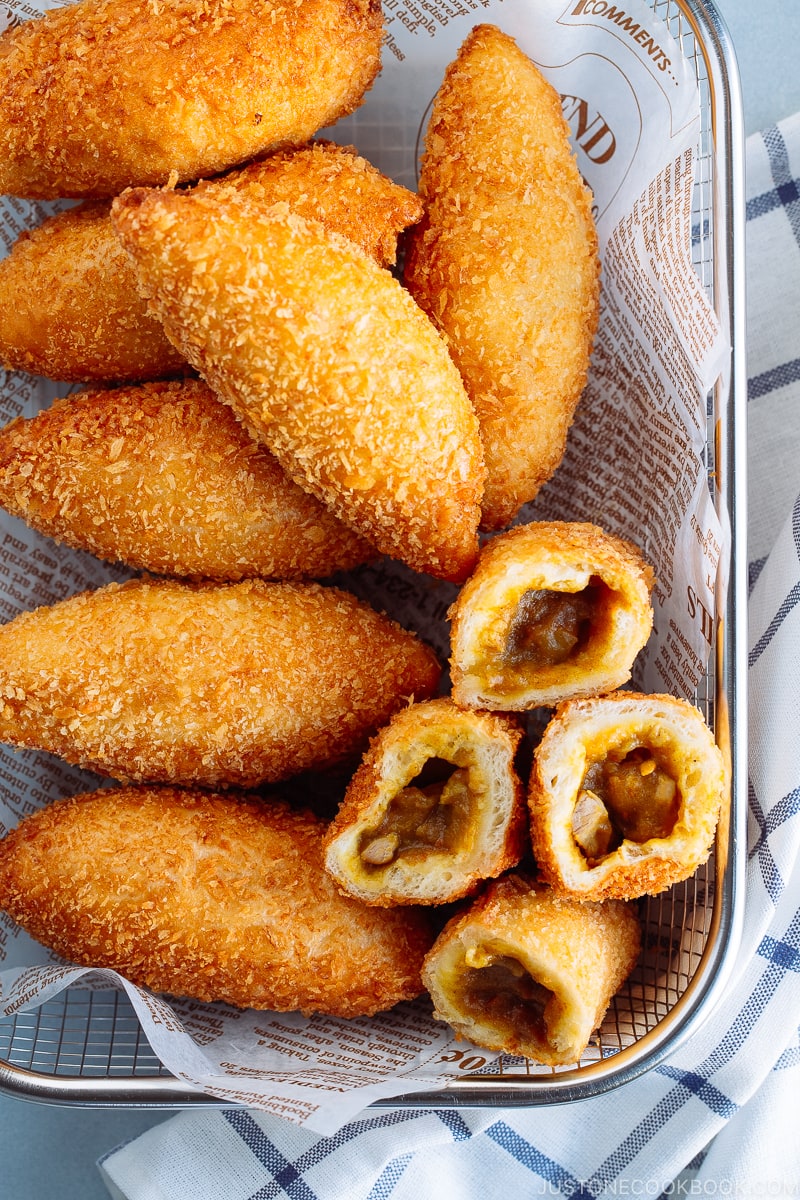
Kare Pan (カレーパン), or Japanese Curry Bread, is one of the most popular savory pastries at Japanese bakeries, along with Yakisoba Pan. There’s nothing more satisfactory than biting into a warm, crispy, and chewy bread that reveals mildly spiced Japanese curry inside, like a passageway to pure happiness. I know you’ll be obsessed with this homemade curry bread once you make it.
What is Curry Bread (Kare Pan)?
Curry bread (kare pan) is Japanese curry encased in bread dough, lightly covered in panko bread crumbs, and then deep-fried till golden brown. Justifiably qualified as comfort food, you can find these curry bread at bakeries and convenience stores throughout Japan. They are enjoyed for breakfast, lunch or snack, or any time of the day in my case.
Mr. JOC won’t leave a bakery shop in Japan without purchasing curry bread, and he’s always searching for the best one. I asked what is considered the best curry bread, and he said:
- The outside crust should be crispy when you bite into it.
- The bread should be chewy but not too thick.
- It shouldn’t be oily even though it’s been deep-fried.
- A good amount of curry should be filled throughout the bread.
As you can see, I have a tough customer at home. Since I welcomed a good challenge, I took it up as an encouragement to develop a good recipe!
There’s nothing fancy about the homemade curry bread. They are just downright tasty. Although it can be time-consuming, it’s totally worth the effort and time because you’d be rewarded with the tastiest bread. The triumph feeling is worth celebrating. I’d make this bread at least every quarter of the year!
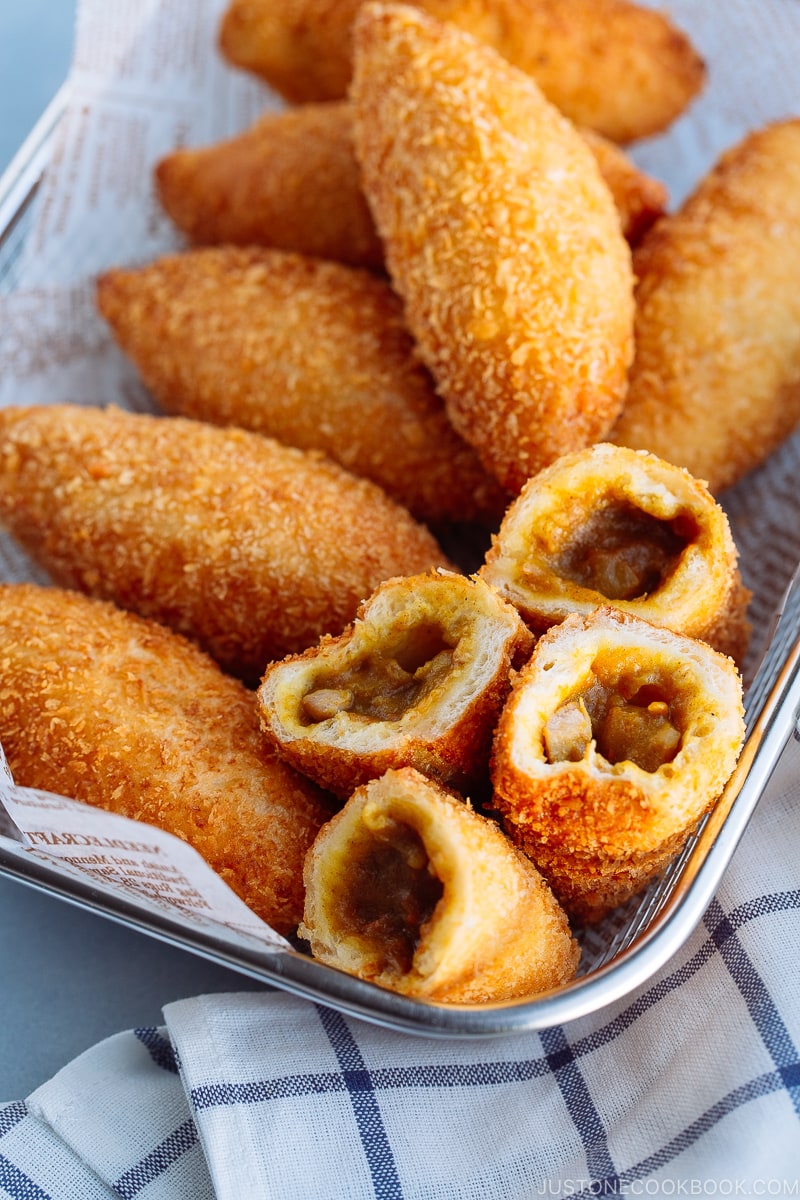
The Japanese Curry Filling
The best part about making your own curry bread at home is that you can stuff the bread with your favorite, delicious curry! Plus it’s the perfect way to use up one big batch of Japanese curry. You will only need about 1 1/2 cup worth of leftover curry. It has to be chilled, so leftover curry from the previous night makes the most sense for this recipe.
You can make Japanese curry with any ingredients you like. I used my Japanese Chicken Curry recipe for my curry bread. You can use other types of meats as well.
The curry next day should be in a thick paste form as you will be bundling up the curry filling in bread dough. Soupy curry is a no-no. Once you refrigerate your curry, it will solidify and easier to handle. Just take out the curry when you start making the bread, so it reaches room temperature by the time you fold it up in the dough.
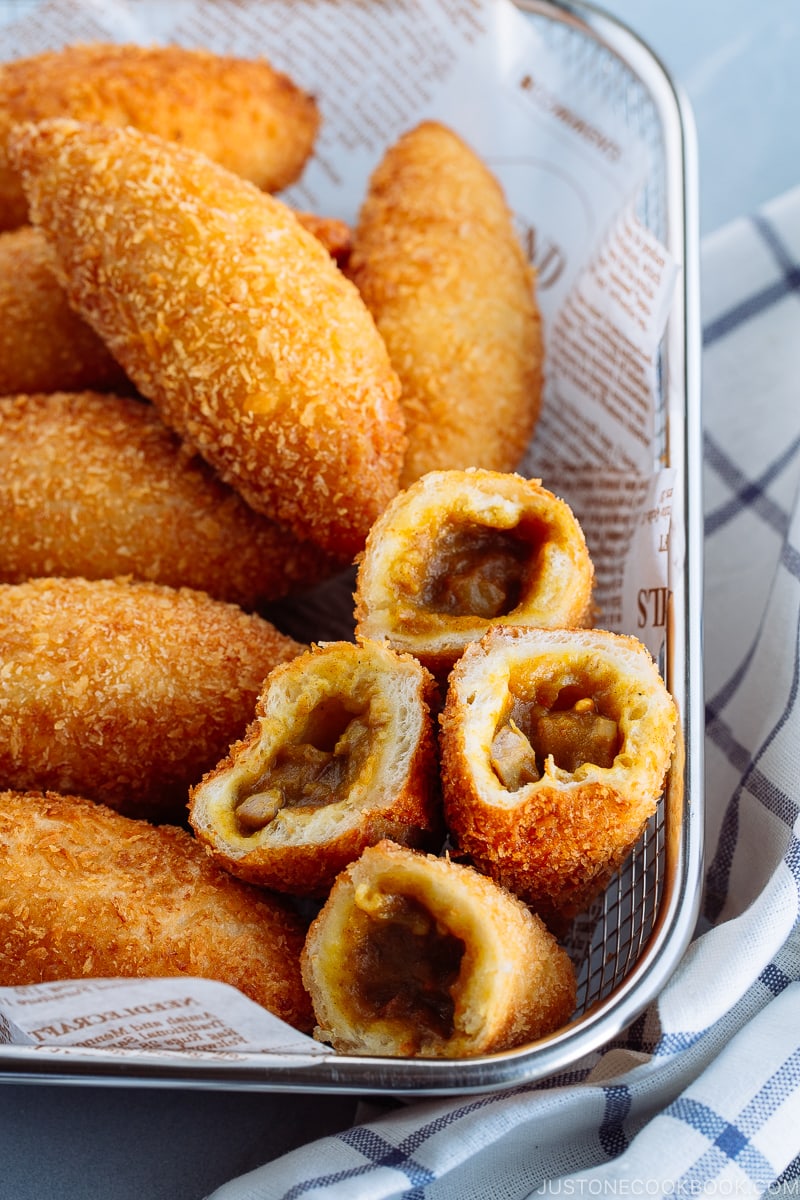
3 Important Cooking Tips
1. Thin out the dough only at the edge
I learned from my experience that I enjoy curry bread more when the dough has a chewy texture. Initially, I thought I prefer thinner bread because it has a nice crispy texture. But when I tasted the chewy and springy bread, I knew the whole curry bread experience got elevated.
To achieve this, it’s important not to roll out the dough too thin. The best way is to thin out only the edges of the round dough with fingers, keeping the center thicker. So when you fold and pinch the edges, the seam won’t be too thick and doughy, and the bread has even thickness throughout.
2. Do not overfill the curry paste
I’ve made this mistake and learned the hard way. When you place the curry filling on a round sheet of dough, make sure you have PLENTY of space around it so you can pinch the dough easily and tightly. You don’t want to overfill because if the curry touches the edge of the dough even a little bit, the pinched dough may pop open and the curry filling will fall out easily during the proofing and deep-frying stages.
If you accidentally made the mistake, here’s what you can do.
a) If the pinched dough is opened up before deep-frying, you can toast the panko first until golden brown, then bake the bread at 375 ºF (190 ºC). This is the same technique as my Baked Tonkatsu/Chicken Katsu recipes.
b) If the dough opened up during deep-frying, you want to immediately stop deep frying, instead gently remove the bread dough from the oil, pop them straight into the oven at 375 ºF (190 ºC) and bake until golden brown.
3. Flip the bread as soon as you place it in the oil
During the second proofing stage, the sealed side is on the bottom, and the dough is rising up. Now when you deep-fry, you will again place the sealed side down first. As deep-frying starts, the dough continues to rise from the bottom (seam side), and it tends to rise way too much, creating a cave inside the bread.
My high school friend Takafumi who used to work at a bakery in Japan shared a pro tip with me when I was struggling with this. He told me that you will need to flip the bread a couple of seconds after you place the dough in the oil, stopping the dough to rise in the same direction. This actually works magically! No more big cave in the bread!
Now that I’ve perfected my Kare Pan recipe, Mr. JOC no longer has to go out his way to hunt down the best curry bread because the best is always the homemade type. Are you ready for your Japanese curry bread mastery? Let’s get started!
More Fun and Delicious Snacks
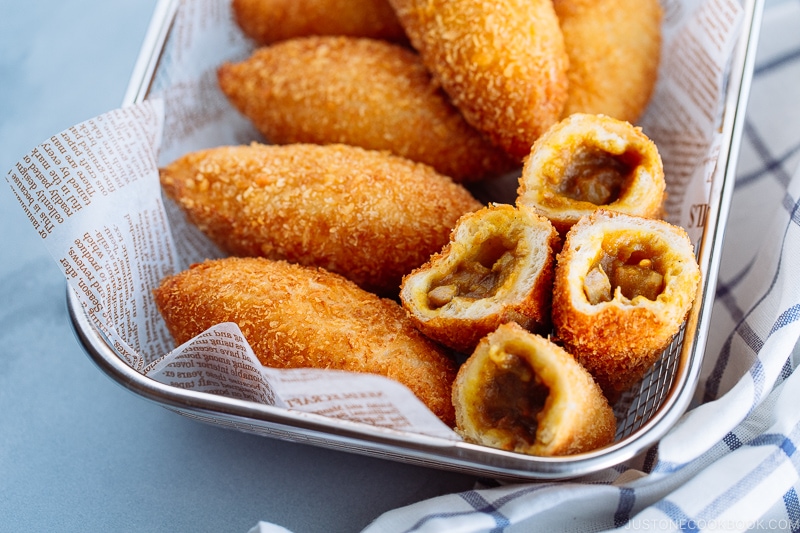
Wish to learn more about Japanese cooking? Sign up for our free newsletter to receive cooking tips & recipe updates! And stay in touch with me on Facebook, Pinterest, YouTube, and Instagram.
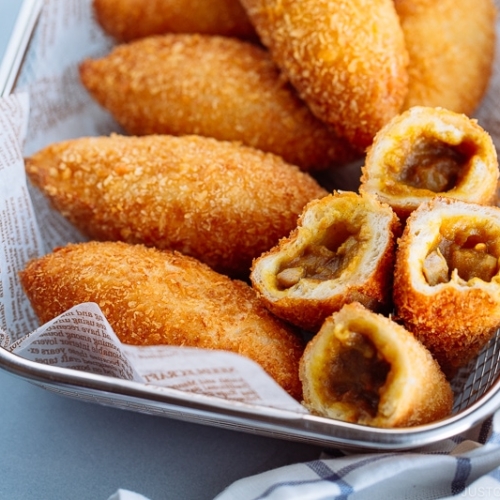
Curry Bread
Ingredients
- 1¼ cups bread flour (weigh your flour; for weights, click the Metric button; or use the “fluff and sprinkle“ method and level it off)
- 50 g cake flour (⅓ cup + 1 Tbsp; you can make cake flour at home)
- 1 tsp Diamond Crystal kosher salt
- 15 g sugar (1 Tbsp + ½ tsp)
- 125 ml whole milk (½ cup + 1 tsp; I highly recommend whole milk instead of nonfat or reduced-fat milk)
- 1 tsp instant yeast (to use active dry yeast, see Notes at the end of the recipe)
- 10 g unsalted butter (a bit less than 1 Tbsp (14 g); at room temperature)
- 1½ cups Japanese curry of your choice (at room temperature; made the day before and refrigerated overnight; aim for a solid, pasty texture; you can make my Beef Curry, Chicken Curry, or Instant Pot Curry recipes)
- 1 large egg (50 g each w/o shell) (for coating the bread with panko)
- 1 cup panko (Japanese breadcrumbs)
- 4 cups neutral oil
Instructions
- Gather all the ingredients. Leave the unsalted butter and Japanese curry at room temperature. I highly encourage you to weigh your ingredients using a kitchen scale for this recipe. For weights, click the Metric button above to convert the measurements to grams. If you‘re using a cup measurement, please follow the “fluff and sprinkle“ method: Fluff your flour with a spoon, sprinkle the flour into your measuring cup, and level it off. Otherwise, you may scoop more flour than you need.

To Mix the Dough Ingredients
- In a large bowl, whisk together 1¼ cups bread flour, 50 g cake flour, 1 tsp Diamond Crystal kosher salt, and 15 g sugar.

- Microwave 125 ml whole milk until warm to the touch, about 95ºF (35ºC). Then, add in 1 tsp instant yeast to the warm milk.

- Add the wet ingredients to the bowl with the flour mixture. Using a silicone spatula, combine together until it becomes a rough dough, about 1–2 minutes.

- Once the dough becomes a ball, add 10 g unsalted butter to the center of the dough and combine until the butter is well incorporated, about 2–3 minutes. At first, the dough will be sticky, wet, and oily and you might want to add more flour, but wait and try mixing it a little longer.

To Knead the Dough
- Once you don’t see any big chunks of butter, transfer the dough to a lightly floured surface. Knead the dough until it becomes smooth and pliable, about 5 minutes. Read the tip on kneading below.

- Tip on kneading: Using the lower part of your palm, push out the dough. Then, roll back up as if you’re drawing the number “8” with your hand. Rotate the dough 90 degrees every time you finish drawing a figure 8.

- After drawing a figure 8 a few times, bang the dough onto the work surface and fold it over away from you. This helps develop the gluten (elasticity). Turn the dough 90 degrees and repeat drawing the number 8 again. Continue this process until the dough is smooth, supple, and silky.

- When the dough is moist, smooth, and pliable, form it into a ball. Place the seam side down on the working surface and twist the ball a few times to close the seam.

The First Rise (Bulk Fermentation)
- Place the dough back in the bowl, seam side down. Cover with plastic wrap. Let it rise at 100ºF (38ºC) for 60 minutes, or until doubled in size. I used the proof setting in my oven. Tip: See my Shokupan post for tips on creating a warm environment for your dough.

- To use the finger test, dust your finger with flour and poke the center of the dough. If the hole doesn’t close up, it’s ready to divide. If the dough closes up immediately, proof the dough a little longer and test again.

To Divide the Dough
- Transfer the dough to a lightly floured surface and gently punch/press it down.

- Fold the dough into thirds widthwise.

- Fold the dough into thirds lengthwise.

- Turn upside down so the seam is facing down. Twist the dough to form a nice ball shape.

- Weigh the dough on a kitchen scale and divide the number by 8. Roughly cut the dough into 8 pieces.

- Weigh each piece of dough and cut off any extra if it weighs more than you calculated.

- Add the extra dough to the smaller dough piece(s). Hide the extra dough in the center of the ball by pulling down the dough from the sides.

- Twist the dough to seal the seam on your hand. Place the dough balls on a baking sheet lined with a silicone baking mat or parchment paper. Cover with plastic wrap, and let rest for 15 minutes at room temperature.

To Roll Out the Dough
- Working on one dough ball at a time, place the dough seam side up and flatten it with your hand. Fold in thirds widthwise.

- Fold in thirds lengthwise, and then turn it upside down so the seam side is on the bottom.

- Flatten again, and flip so the seam side is up.

- With a rolling pin, roll it out into a 3½-inch (9-cm) circle. Repeat with the remaining dough balls.

- Cover with plastic wrap and let rest for 10 minutes. One by one, pick up the dough circles. Pinch the edges with your fingers to thin them out while leaving the center thicker, to about 4 inches (10 cm) in diameter.

To Shape the Curry Bread
- Working on one dough circle at a time, place it seam side up. Gather 1½ cups Japanese curry of your choice. Add 1 to 1½ Tbsp curry sauce to the center of the circle. Do not overfill. Remember, KEEP THE CURRY AWAY from the edges! It’s the most crucial part. If you didn’t read my blog post, read tip #2 now in the post.

- Gather the opposing edges of the circle and fold the dough in half. Tightly pinch and press the edges to seal well so the seam does not open up during proofing and deep-frying.

- Next, to double secure the seam, fold the edges over to one side at least once, like folding a brown paper lunch bag. Press the edges again to secure.

- Place the bread, seam side down, back onto the tray with the silicone mat. Cover with a damp towel while working on the rest of the dough.

- Once you‘ve formed all the curry bread, crack 1 large egg (50 g each w/o shell) into a bowl and whisk well. Place 1 cup panko (Japanese breadcrumbs) in a shallow bowl/tray. Using a pastry brush, coat them with beaten egg and then panko.

The Final Rise (Proofing)
- Cover the bread with plastic wrap and let rise at 100ºF (38ºC) until 1½ times its size, for 45–60 minutes (I used the proof setting in my oven). If you touch the dough with your finger and the indentation remains, it‘s ready.

To Deep-Fry the Bread
- If you‘re new to deep-frying, please read my post on how to deep-fry food at home for tips on safe and successful frying. In a deep-frying pot (I use a 2.75 QT Staub), heat 4 cups neutral oil to 320ºF (160ºC). Place 2–3 pieces of the curry bread into the oil, seam side down. After a few seconds, flip it over so the seam side is now up. You may need to hold it with a pair of tongs. Keep turning them while they deep-fry, until they cook to a golden brown, about 2–3 minutes. Drain the oil well and transfer to a wire rack or some paper towels to drain while it cools.

To Serve and Store
- Serve hot or at room temperature. Keep the leftovers in an airtight container and store in the refrigerator for 3 days or in the freezer for 3–4 weeks. To reheat, bake at 350ºF (177ºC) until warm inside.
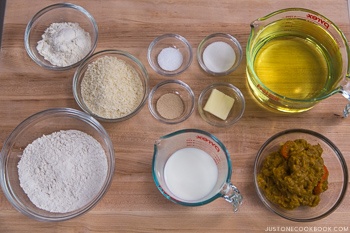

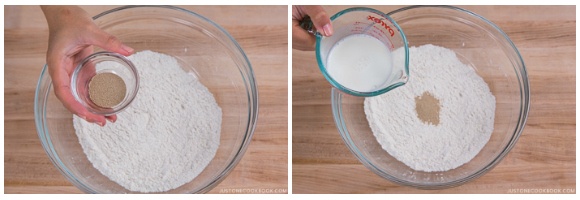


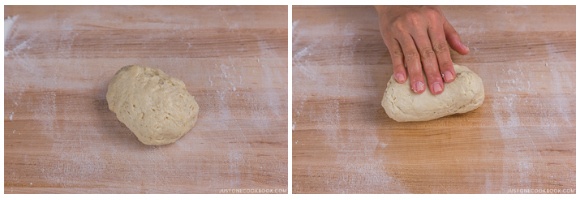

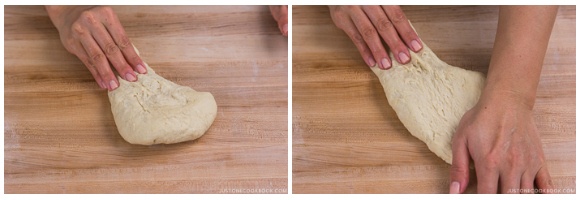
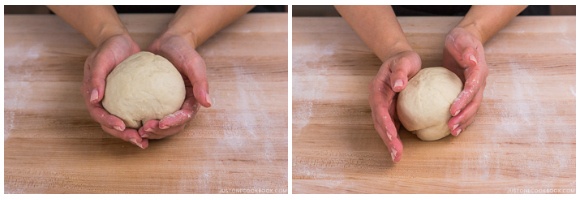
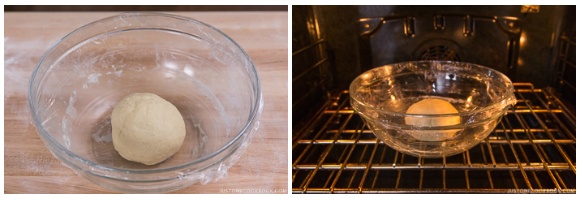

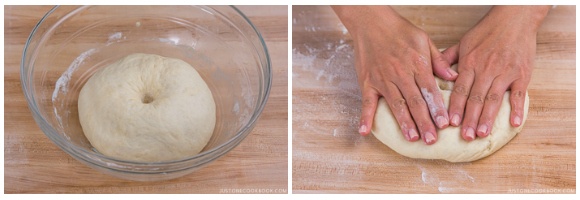
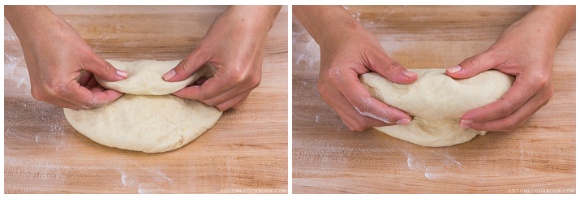
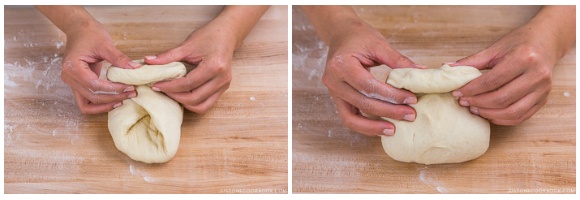
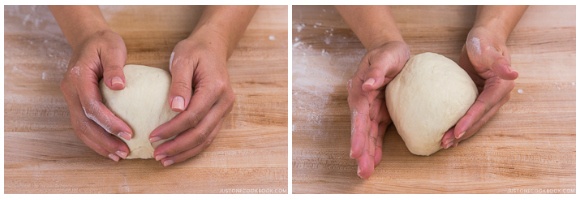


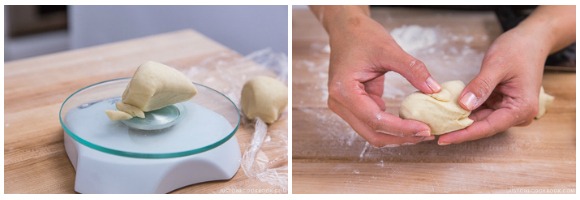
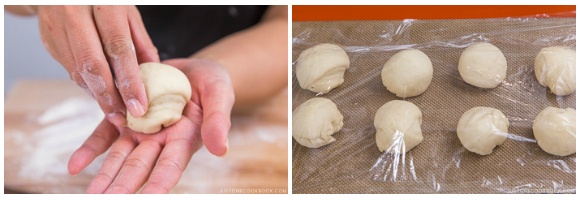


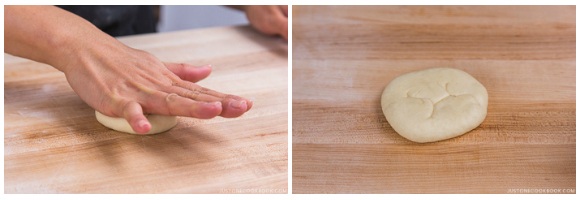
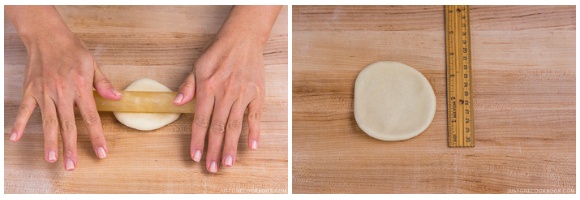
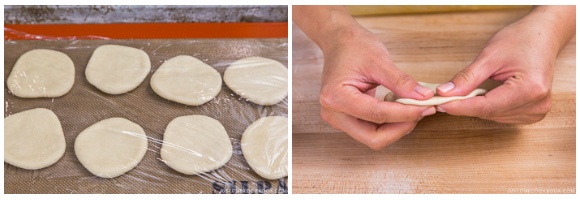
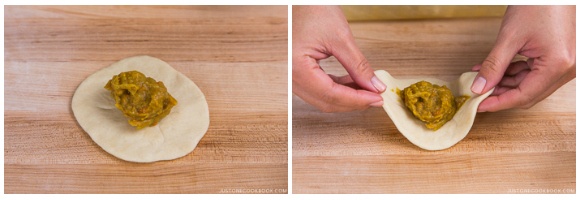
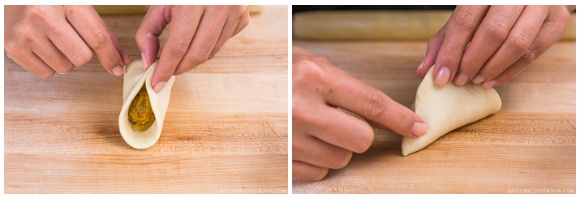
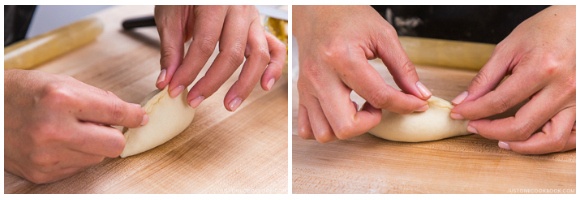
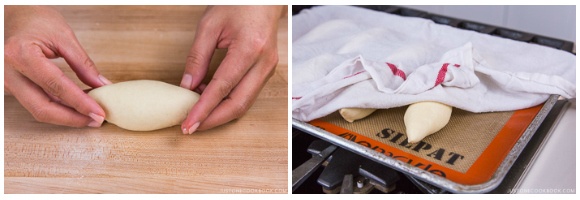
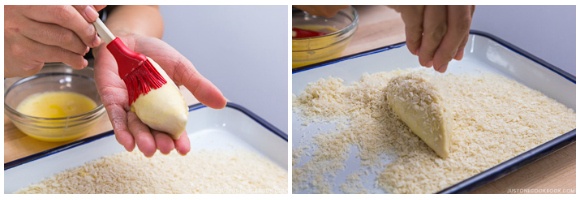
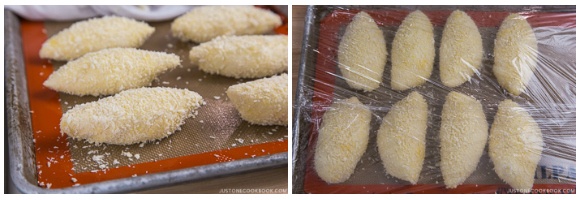
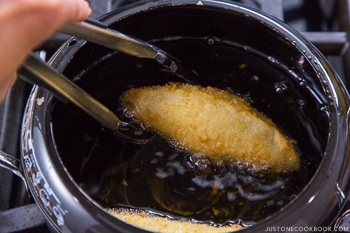











Hello! I made it and it was so good ^^ I didn’t have breadcrumbs so I expected it to not taste as good when I used grinded bread but it was crunchy and amazing!!! it was my first time making it and I didn’t fold it the best but it was so good !!! I’m getting breadcrumbs next time though!
Hi Eshaal, Excellent! We are so happy to hear your first time Kare Pan came out great!
Thank you very much for trying Nami’s recipe and for your kind feedback.
Hi Nami! I was wondering–could I make the dough and then refrigerate it to use the next day? What steps would I have to do if this is possible?
Thank you!
Hi Rashmi, Thank you very much for trying Nami’s recipe!
Some bread, you can refrigerate after you shape them. You are slowing the second proofing in the refrigerator.
However, we haven’t tried the technic with this recipe, and not sure how the outcome will be, but you can try?? We recommend restart from step 10 the next morning and cover with panko and deep-fry.
We hope this works!
I was a little intimidated when I first saw your recipe. Since we have been quarantining for so long I decided I was up for the challenge. Thanks to your detailed nstructions and helpful tips I am happy to say they turned out perfectly. Well, I did get the care cave you warned about. I will work on it next time. The bottom line is they tasted fantastic and the bread was delicious. I am slowly cooking my way through your website and cannot wait to try the next recipe!
Hi Suzanne, Wow! Thank you very much for trying this recipe and for many other recipes from our website.
We are so happy to hear you enjoyed the Curry Bread. Thank you for your feedback!
Wait… How do we make the Japanese Kare? please teach me
Hi Niv, The link to Curry recipes is in the recipe card. Please click: “Here are recipes for Beef Curry, Chicken Curry, and Instant Pot Curry)” in the ingredients list. Thank you very much for trying this recipe!
Hey. I have no idea what I’m doing wrong because no matter how little curry I put in, it comes spilling out the sides when I attempt to bring the edges together. How do I close them without the curry jumping out due to pressure?
Hi Taylor,
Thank you very much for trying this recipe!
Did you have a chance to read “3 Important Tips” in this post? If you overfill the curry or the curry touches the edge of the dough even a little bit, the pinched dough may pop open, and the curry filling will fall out easily during the proofing and deep-frying stages. So please make sure the edge are clean and pichi it together.
We hope this helps!
I did. I used less than a teaspoon of curry in one and still had it popping out when I went to fold it. There was a good inch between it and any edges when I started, but when I folded it came exploding out. I didn’t even get to seal it before it failed. It seems like the pressure of the folding in the middle pushes it all outward – how do I prevent this from happening?
Hi Taylor,
I see…
When you fold the edges together, did you fold it on the counter table or in your hand?
If you see Step 6 and 7, Nami never lifts the dough from the table, and stretch the edges to seal it.
This will help to seal the edges without touching the curry and no pressure by folding it.
What do you think? Is this helpful?
I left it in the pan. Not sure what is meant by stretching to close it – after doing the pressing to thin out the edges, any more stretching would tear the dough. So I pick up the edges, but it ends up putting pressure on the center…
Hi Taylor,
I meant to say slightly stretch the dough out from the middle and bring it back together to wrap. Therefore it is not pushing the curry.😉
You may also start to tightly pinch/seal from the side first.
We hope this helps.
I had something like this at a train station in Japan, also one that had melty chocolate inside that was super yum …
Hi Adam!
We are glad to hear you had a chance to try Japanese Kare Pan! Yes! It’s yum!
hi! would it be possible to bake this bread after spraying it with some oil after adding the panko because i dont own a thermometer nor the equipment for frying food… would it also be possible to try to make round breads like how anpan is shaped? thank you!!
Just tried this last night and it was fantastic! That dough is fantastic, glad to see it can be used to make other recipes, which I’m going to be trying out real soon!
Some things that I had to change up:
1. Was step #11 a typo? I didn’t have enough time to let it rise and they still came out fine (after the first time it rose.
2. Had about 30 grams less of flour and used semolina flour.
3. My oven doesn’t go down to 100F, so I turned it to it’s lowest (170F) and then turned it off.
Hi Minh,
Thank you very much for trying this recipe and for your kind feedback!
This recipe has first proofing, bench time, and second proofing to make a better texture. The second proofing will help the dough to become more finely and softly. So it can be skipped, but the result will be different.
We hope this helps! 🙂
Hi Nami, when I was travelling in Japan last December. I accidentally found this curry bread in one of the bakeries at Fukuoka train station. I had fallen in love with it….it was so yummy 😋 and I ate it every day (I stayed there for 3 days)..haha
Now I am so happy to found your recipe of making my favorite curry bread🥰
But I have a question about the cake flour substitute with AP flour.
1 cup of cake flour =120g
For every 1 cup of all-purpose (AP) flour, remove 2 tablespoons of AP flour.
Add 2 tablespoons of cornstarch for every 1 cup of AP flour.
However, the recipe is only using 50g cake flour, may I should I substitute it with AP flour?
Thanks and like to hear from you soon. Have a good day😊
Hi Dana,
We are so glad to hear you had a chance to eat Curry bread in Japan! They are so yummy! 😋
To make 50g of cake flour, I recommend to make a half cup of cake flour first and use 50g from it.
1) Prepare 1/2 cup all-purpose flour
2) Remove 1 Tbsp from it
3) Add 1 Tbsp cornstarch
4) Sift it well together a few times
5) Measure 50 g
I hope this helps!
Dear Nami,
I made this recipe and it worked perfectly:) a couple popped open in the fryer so transferred to the oven and that worked great too. I need to work on the sealing technique. This is the first time I’ve had these since living in Japan 15 years ago and I couldn’t have been more delighted with the result. Thank you so much! 🤩❤️
Hi Rochelle,
We couldn’t be happier to hear how much joy and excitement my recipe has brought to you!
Thank you so much for trying this recipe and for your kind feedback.💕
I. Love. This. Recipe.
I tried a few other curry bread recipes before this one. The dough Nami makes is superb! It almost makes you feel a little guilty, like you’re eating a donut dough with your curry…
I tend to make my curry chunky, so make sure you dice things a little smaller for the filling. And like she says, don’t let the curry get in the seams! It will make the bread crack open during frying if you do.
Hi Kristine,
Thank you so much for trying this recipe and for your kind feedback. We’re so glad to hear you LOVE this Kare Pan! We love it too.😋
Thank you for sharing your cooking experience/tips with us!
The Kare Pan was a showstopper! It was a lot of work, but boy, so very delicious. The bread had the perfect crunchy exterior and chewy interior. Miraculously none of mine broke open during frying. The tip for turning them as soon as you put them in is really needed. The ones that I was seconds late to turn inflated like a balloon on one side and didn’t want to flip over. As I was making them I was thinking, these are a lot of work, not sure I’ll be making them again. But now I can’t wait to make them again! I am thinking about all kinds of different curry fillings. I used chicken and vegetables for this one, and am thinking of beef or lamb for the future.
Hi Dorothy! Ohhh I’m so happy to hear you tried my Kare Pan. I agree, it’s A LOT OF work, but it’s something about this bread that is so addicting that I want to make a few times every year… I’m sure you pinch and seal the dough correctly. I’m glad! That’s my biggest concern for my readers for this recipe. Honestly, only people who made this will continue making it. Nothing like just out of the fryer Kare Pan. It’s a total win. My gosh, I just drooled imagining that. LOL!!!
I went to a bakery at the Mitsuwa in Costa Mesa and they have curry donuts and egg donuts. Any idea how you’d make the egg ones? Same dough and just put a ramen egg inside?
Hi Candace! I had never had it before, but sounds delicious! Not sure what type of eggs, but possibly the ramen egg (Ajitsuke Tamago, the seasoned eggs). Deep-fried dough like curry bread, right?
Hi Nami,
The base recipe seems good, but unfortunately following your recommendations for proofing times and temperatures resulted in badly overproofed kare pan which couldn’t hold its shape for frying. Maybe Norwegian yeast is more active? Will try again with some adjustments.
Hi Sigve! Thanks for trying this recipe! Hmm… also room temperature too. My kitchen/SF is always cool, so my dough don’t overproof fast. It’s summer now and that might affect….
Hi Nami,
I made this recipe yesterday for my family. It turned out very delicious but I had a couple of questions. One is about the rolling. After separating into eight pieces and allowing the Delta rest even recommend doing a fold into thirds and another fold into thirds. After I did this it was very difficult to roll the dough into a circle. It was a square. Is the stuff really necessary? Also I felt that the bread needed more curry filling. Before you add a tablespoon and a half of curry do you chop up your veggies smaller? It just seems like it needed more curry in there to me. Also I was a little bit confused about the shaping. What do you mean when you say to fold the dough like you would a brown paper bag? My bread turned out a little bit lumpy and not perfect like yours. But it still tasted good! Last question… Would it be possible to farm these breads and freeze them so I could fry them in the morning on school days for my kids?
Hi Cristen! Thanks for trying my recipe and here are my answers.
1) Yes, you need to fold into thirds (it’s a very common method in bread making). I’m afraid you overknead the dough. The dough has developed too much gluten, causing the dough to be overly firm. When the gluten has been over developed due to too much kneading, it will be tight and have almost no give. So you have to probably let the dough sit and rest, untouched for a while. It should not be too difficult to fold into thirds.
2) You can add more curry filling. If the curry is more solid, it’s a lot easier too. And once you know how to seal the dough tightly, without the curry sauce touch the edges of the dough, you can put as much curry as you like. It’s easier to work with small amount of curry, because like I explained, it’s nightmare if the curry starts spreading and touch the edges of the dough. You won’t be able to close/seal the dough at all.
3) Folding like a brown lunch bag. American kids usually bring lunch in a brown paper bag, so that’s what I meant. It’s like a gift bag, and you fold the top of the bag (open side) 2-3 layers. That’s how you want to fold the edges of the dough. Not about shaping, but it’s more about the way you seal the edges.
Hope I answered your questions!